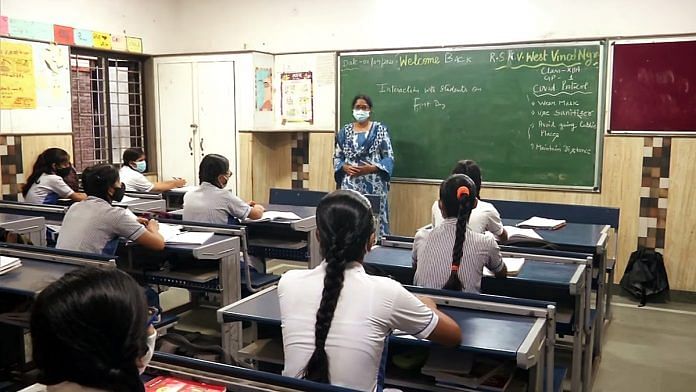New Delhi: Children in the national capital suffer from higher levels of respiratory problems as compared to counterparts from Mysuru in Karnataka and Kottayam in Kerala, where pollution levels are much lower, a study has found.
Led by the NGOs Lung Care Foundation and Pulmocare Research and Education Foundation, based in Delhi and Pune, respectively, the study sought to compare the respiratory health of adolescent school children in Delhi private schools with those studying in “relatively cleaner cities in terms of particulate matter air pollution”.
In 2019, Delhi’s annual average pollution levels were between 154 and 217 μg/m3 for PM 10 (particulate matter 10) and between 79 and 128 μg/m3 for PM 2.5.
The annual average PM 10 levels in Kottayam and Mysuru were around 40–50 μg/m3 and those of PM 2.5 between 15 and 30 μg/m3 in the same period.
“The prevalence rates of cough, shortness of breath, chest pain/tightness, blocked nose, sneezing, itchy watery eyes, eczema, and itchy skin were reported to be significantly higher in children living in Delhi,” found the study.
It was released Wednesday and published in the peer-reviewed Lung India journal.
Also read: In Firozabad, ‘dengue-like’ disease has killed 32 kids in 11 days. No one knows what it is
Obesity ‘linked’ with asthma in Delhi
The study recruited 928 students from Delhi (55 per cent were boys), 1,040 from Kottayam (40 per cent boys), and 1,189 from Mysuru (58.4 per cent boys), and compared their lung health by using a questionnaire, measuring their heights and weights, and conducting a spirometry test (meant to examine functioning of lungs).
All students were selected from private schools, so as to “minimise the confounding caused by low socioeconomic class, under‐nutrition, overcrowding, and indoor air pollution, risk factors that are relatively common in children studying in public schools”.
The study compared the figures from Delhi against the combined numbers from Mysuru and Kottayam.
Among its key findings were that students in Delhi were over twice as likely to suffer chest tightness compared to students in Mysuru and Kottayam — 11.2 per cent in Delhi against 4.7 per cent in the other two cities — and had much higher rates of shortness of breath (31.5 per cent against 10.8 per cent).
The study also found that more than half of Delhi students (55 per cent) suffered from sneezing compared to 39.3 per cent in the other two cities, and eczema was nearly five times more prevalent in Delhi compared to the other two (8.7 per cent versus 1.7 per cent).
Children in Delhi also reported higher rates (29.3 per cent) of airflow obstruction/asthma compared to Mysuru and Kottayam (22.6 per cent) despite family history of asthma and smoking being more prevalent in the latter.
It also found that children living in Delhi were more likely to be overweight or obese, and that their conditions were “strongly associated with airflow obstruction/asthma defined on spirometry”.
Dr Sundeep Salvi, Director of the Pulmocare Research and Education Foundation and one of the researchers on the study, said in a statement: “This is one of the first studies in India among adolescent school children that has shown a strong association between obesity and asthma, and that air pollution may have a direct link between the two. Breathing polluted air can make children fat and this may increase their risk of developing asthma.”
Recommendations
The researchers, including lead author Dr Arvind Kumar, founder trustee of the Lung Care Foundation, and Dr Anurag Agarwal, director, CSIR-Institute of Genomics and Integrative Biology, recommended in their statement that policymakers “be made aware about the potential link between air pollution obesity and asthma”.
“Stringent measures need to be taken on an urgent basis to reduce the ambient air pollution as well as obesity in adolescent children,” they said.
They also called for a repeat of the study with a larger sample size involving students from public schools, “to be more objective”.
(Edited by Amit Upadhyaya)
Also read: Steep rise in heart disease risk among women as more take up full time work: Swiss study






